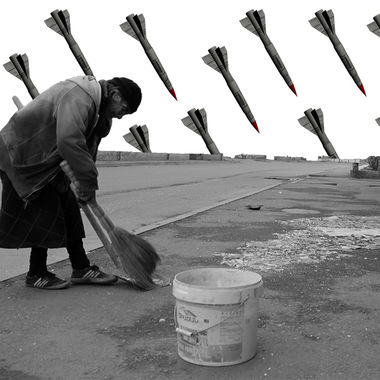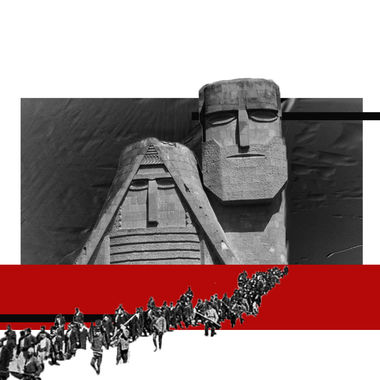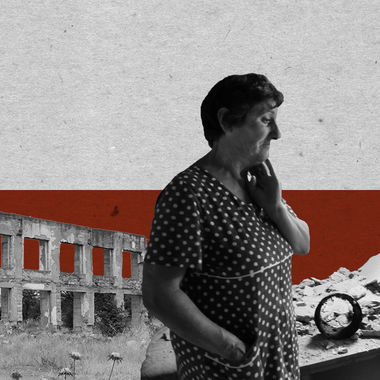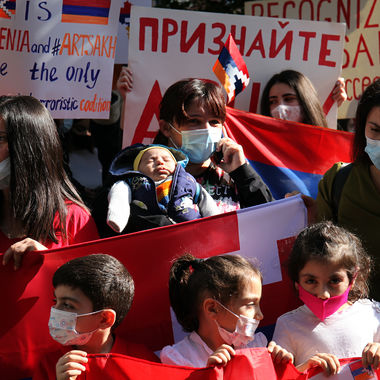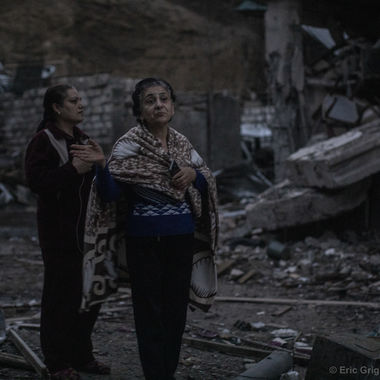Fri Oct 23 2020 · 11 min read
War, Nothing But War: The Virtue of Brute Force and the Shortcomings of Diplomacy

By Nerses Kopalyan
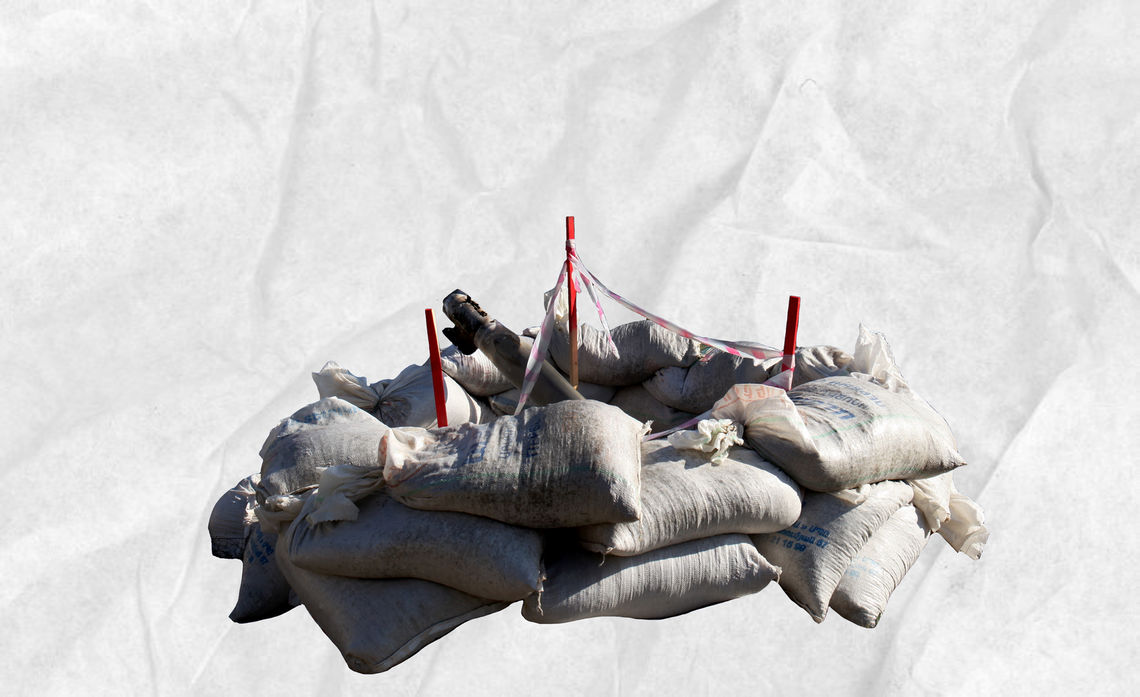
In the face of brute force, diplomacy shirks. In the realm of combat, compromise is untenable. In the domain of total war, only collective strength remains an option. Azerbaijan had already made the decision, but now Armenia has come to that same realization: War, nothing but war.
For observers of the South Caucasus, it was immediately evident that Azerbaijan’s initiation of military conflict on September 27, 2020 against Nagorno-Karabakh, and by extension the Republic of Armenia, was profoundly different from all prior skirmishes. Immediately, as the first set of rockets launched by the Azerbaijani Armed Forces began to land, there was very little doubt that full-scale hostilities had broken out. Simply put, it was quite clear that this was total war. This clarity was based on a single indicator: Azerbaijan began the conflict by immediately crossing a red line and bombing the capital of Stepanakert. Since 1994, regardless of the range and scope of skirmishes, including the 2016 Four Day April War, Stepanakert remained outside the theater of operations. There was a clear and explicit understanding by both sides that if this red line was ever crossed, the conflict would immediately explode into total war. Thus, once the first rocket landed on Stepanakert on September 27, total war had been declared by Azerbaijan. There was also another important point made clear by Azerbaijan’s military barrage: diplomacy and international law will have neither priority nor substantive relevance.
There have been general hopes expressed, by both domestic and international stakeholders, that the fighting may perhaps be for a limited scope of time, or perhaps a ceasefire may be secured, or that a diplomatic breakthrough may be entertained after the horrors of war overwhelm both sides. While such sentiments are clearly understandable, there should not be any illusions: this is all wishful thinking. When a conflict is initiated by all red lines being crossed, the prevailing doctrine is reduced to a common denominator: the outcome will be determined on the battlefield.
The enormity of the fighting is unlike anything the South Caucasus has seen, with both sides utilizing more advanced technology, more destructive weaponry, and a deeper and visceral drive to destroy one another. This discourse on “fifth generation warfare” is compounded with a new wild card: the overwhelming presence of Turkey, who has encouraged, armed and diplomatically supported the Azerbaijani invasion. Further exacerbating the already-complex situation has been Turkey’s deployment of mercenaries from Syria, a mix of jihadists and militiamen that Turkey has stationed in other theaters of war, such as Iraq and Libya. With this traditionally localized conflict now bearing all signs of being internationalized, the omnipresence of Russia in the region, as a security ally of Armenia, further complicates the power configurations. The narrow geopolitical framework of this three-decade-old conflict is now threatening to become a Eurasian nightmare: Turkey's involvement has sensationalized the war, Iran’s unease has reinforced the confusion, while Russia's perceived passiveness has created much regional anxiety.
Power Configurations and the Battlefield
Azerbaijan’s objective, directly declared by its President Ilham Aliyev, remains singular: the complete conquest of Nagorno-Karabakh. Evident to all observers, this is neither a negotiating posture, nor a basis for any framework of compromise. But this should not come as a surprise. Every student of this conflict knew this. Either the status quo was going to be preserved by Armenia’s capacity for military deterrence, or Azerbaijan was going to initiate an all-out war to alter the status quo. To this end, President Aliyev’s promise of total victory to his people has inherently limited his ability for any diplomatic compromise. When the bar is set at the most maximalist position, the appetite for total victory blinds itself to diplomacy or international law. Brute force, glorified in a cult of jingoism, becomes the mantra.
Did it have to come to this? Inevitably! For the last 26 years, it has not been in the interest of either side, Armenia or Azerbaijan, to resolve the conflict through compromise, considering the sacrifices that a resolution required. This has brought about a concept which I qualify as “the incoherence of peace.” For both parties, peace, that is, an equitable peace, has not been the solution. More concretely, when both sides speak of peace, they mean completely different things. In no uncertain terms, each side seeks a specific type of peace: Peace on their own terms. Therein lies the incoherence of the last 26 years. The terms and interests of the two parties have become so diametrically opposed, that the minimal level of compromise required to ascertain the simplest form of peace becomes untenable. Because compromise has become equated with capitulation, neither the political elite nor the populations of either country were willing to conform. Thus, Armenia continued its policy of preserving the status quo, while Azerbaijan became the revisionist actor seeking to disrupt the status quo.
In a more unqualified sense, the incentive structure for compromise collapsed. From a pure rational choice perspective, Armenia had no incentive to negotiate with the terms stipulated by Azerbaijan. There was neither a cogent incentive, nor a valuable trade-off, in order for Armenia to relinquish some or any of its gains. Thus, in the domain of cost-benefit analysis, status quo preservation became the most beneficial and the most rational choice for the Armenian side. The Azerbaijani position remained just as rigid: understanding the lack of incentives on the Armenian side, Azerbaijan sought to create an incentive structure by initially implementing an ad-hoc war of attrition, followed by the recent declaration of total war. Azerbaijan’s logic presupposes that, if sufficient punitive measures are implemented against Armenia, this will create an incentive for the Armenian side to offer concessions and acquiesce to Azerbaijan’s maximalist demands. Thus, instigating war and shattering the status quo is a continuation of this doctrine.
After nearly a month of intense fighting, three factors have become clear: 1) Azerbaijan’s fundamental policy is defined by irredentism; 2) Armenia, realizing a policy of irredentism is irreconcilable with diplomacy, is digging in for a war of attrition; and 3) the geopolitical developments, especially Turkey’s infringement into Russia’s traditional sphere of influence, has relegated the OSCE Minsk Group, and Russia’s dominance of that group, to the margins.
Substantively, there are two broad dynamics at play: the power configurations between Armenia and Azerbaijan in the battlefield, and the geopolitical power configurations defined by Turkey’s thrust into Russia’s “southern flank.” The first dynamic has framed the domestic narrative of both countries, as well as the narrative in Armenia’s diaspora. The second dynamic reinforces the first dynamic within the Armenian narrative, reifying a singular claim: Armenians of Artsakh are facing an existential battle for survival. This broader narrative has enhanced Armenia’s ability to both grasp the attention of the diplomatic community (though dividends are yet to be seen), while mobilizing and invigorating the resources of its diaspora. The prevailing logic is straightforward: by virtue of Baku’s maximalist position, total victory, inherently, presupposes total capitulation, and as such, the elimination of an Armenian presence in Artsakh. The presence of Turkey further reifies this presupposition, reviving the historic trauma of the Armenian Genocide into the discourse. This narrative, and the developments in the battlefield, however, are two completely different realities. The lamentations of the diaspora, and the empty verbosity of the “international community,” have no consequence on the battlefield. And since the power configurations between Armenia and Azerbaijan are, as of now, being only determined on the battlefield, brute military force remains the defining variable.
Azerbaijan’s war strategy, very likely drawn by Turkish consultants and strategists, envisions a two-pronged encirclement of Nagorno-Karabakh, with massive assaults from the North and the South, with the objective of reaching the Lachin corridor from both flanks and thus fully encircling the Armenian forces, while cutting off all supply lines from Armenia proper. The lack of success in the North has hampered parts of this strategy, so Azerbaijan has adopted a more concentrated assault from the South, seeking to push towards the borders of Armenia proper and then move up towards the Lachin corridor. The mass concentration of fighting in the Southern axis has been especially difficult for the Armenian forces, since Armenia’s method of conducting warfare stipulates an effective use of terrain, such as what is seen in the successful defenses in the North and the central region of Martuni. But the Southern flatland has become extremely difficult to hold, and analytical observations of the Turkish-Azerbaijani war game in July/August clearly demonstrate that a broad ranging strategy had been designed precisely at moving from the Southern flank into Lachin.
Armenia’s general strategy remains one of maintaining a staunch defensive line, but the complications in the South have resulted in alterations to this military doctrine, with strategic retreats in the South allowing the Armenian forces to move to higher ground and thus utilize space in undertaking surgical counter-attacks and efficient use of artillery. Having accepted the fact that this is going to be a war of attrition, the Armenian strategy in the South has shifted from rigid defensive lines to one of fluid operational space. Further, Armenian strategy also indicates an attempt to allow Azerbaijan to over-extend its troops and supply lines in the South, making the aforementioned surgical operations more feasible. These tactical alterations, however, remain ad-hoc solutions to a broader issue: unless Armenia undertakes consistent and sweeping counter-attacks in the southern axis, the threat against the Lachin corridor will not be alleviated.
Power Configurations and Geopolitics
In the realm of geopolitical discourse, the Nagorno-Karabakh conflict was never assessed through the lens of geopolitical power configurations, because a single power determined those configurations. But with Turkey’s attempt to enter the geopolitical fray, the power configurations of the South Caucasus have been disrupted: Russia’s dominance and sway in the region is challenged. Russia’s response has been, to say the least, an intricate mix of confusion and policy incoherence. Taken by surprise by Turkey’s bravado, Russia realized, only after the fact, that it had become overly complacent with its Southern Caucasus policy, and with Turkey taking the initiative, Russia’s traditional policy in the region has collapsed. Accustomed to dictating terms to both sides, Russia now faces an Azerbaijan that is able to tacitly deny Russian pressure, thanks to Turkey’s willingness to provide Baku geopolitical cover. Furthermore, a sphere of influence ceases to be one if the given power’s influence no longer resonates. In this context, Russia is facing an unexpected dilemma: a demand by Turkey to have an equal say in this regional conflict. Needless to say, a stronger Turkish presence in the region inherently diminishes that of Russia’s, yet Turkey’s utilization of a proxy-structure limits Russia’s ability, at this point, to robustly address this problem. In more simple terms, Russia is still figuring out what to do.
This proxy-structure is problematic for Russia for two reasons. First, Russia has very healthy relations with Baku, since it views Azerbaijan as a stable post-Soviet state that never creates headaches for Moscow. Further, Russia maintains important economic and political ties with Baku’s elite, a symbiotic relationship that is commensurate with Russia’s regional interests. Second, Russia understands it must tread carefully when it comes to Azerbaijan, because it has already “lost” Georgia to the West and cannot afford to blatantly push Baku into the arms of a NATO member. It is this second dynamic that Turkey is utilizing quite brilliantly. Understanding Russia’s need for a very nuanced balancing act in its southern flank, Turkey is using Baku as a conduit to disrupt Russia’s traditional dominance of the region. The question, of course, that everyone is pondering over, is obvious: What are Russia’s “red lines” and when will Russia determine that alienating Baku is a more preferable outcome than allowing a Turkish foothold in its southern flank? More specifically, has Russia made the determination that Baku, as an extension of Ankara’s policy, is being used to limit or harm Russian regional interests, or is Russia convinced that Turkey’s recent adventurism in the Caucasus is superficial and ephemeral?
Russia’s biggest concern, at this point, is the fear that the war might spiral completely out of control. This could be one important indicator of why Russia, aside from the analysis provided above, is also being extremely careful in not overly-flaming the conflict. In this light, Russia views Turkey as a spoiler, one whose behavior is not only irresponsible, but could harm regional developments for decades to come. Through this paradigmatic lens, Russia views itself as the responsible regional hegemony, seeking to act constructively, while Turkey acts as the opportunist seeking regional fracturing.
Until Russia develops a more rigid and concrete policy, and even when it does, the axiom will very likely remain the same: everything will be determined on the battlefield. Turkey’s foray into the region was precisely done in this fashion, utilizing Azerbaijan’s performance on the battlefield (and by extension, Turkey’s direct involvement) to create a new reality that allows Turkey’s proxy-structure extensive leverage. This leverage has been visible in Baku’s willingness to disregard two Moscow-initiated ceasefires, as well as Ankara openly undermining the relevance of the Minsk Group. Considering Moscow’s dominance of the Minsk Group as the only accepted negotiating framework for the Nagorno-Karabakh conflict, Turkey’s assault against the Minsk Group is a direct assault against Russian diplomatic and political hegemony of the region. Turkey has made it clear: as long as Baku, through Turkish help, is successful on the battlefield, there is nothing Russia can do diplomatically as long as Turkey does not have a seat on the table. The battlefield, then, remains the determining platform upon which subsequent developments will be shaped.
This premise provides Russia two options: 1) continue low-key assistance to Armenia until Russia more concretely figures out its new regional strategy; or 2) heavily arm Armenia and allow the Armenian side to alter the dynamics on the battlefield. In the case of the former, which has been the reality for the first month of fighting, Turkey’s proxy-structure remains robust and cannot be diminished. This, in turn, further strengthens Ankara’s influence and authority over Baku, thus methodically solidifying Turkey’s foothold in the region. In the case of the latter, Russia risks alienating Baku, but at the same time, Armenian advances in the battlefield will diminish Turkey’s influence over Baku. Facing potential defeat, and inevitable domestic instability if such should happen, Baku would be much more open to conforming to Russian-led negotiations. In this context, Azerbaijani success in the battlefield favors Turkey’s proxy-structure at the expense of Russian regional dominance, while Armenian successes on the battlefield diminish Turkey’s proxy-structure and reinforce Russia’s role as regional arbiter.
The multilayered complexity of this conflict, therefore, is not only specific to ethnic groups, conflicting states or regional actors. It has now become thoroughly interrelated. This interrelation, however, has produced another important dynamic: the importance of agency. This is not a regional proxy war. Every actor involved has agency. There is, indeed, a proxy-structure, but this is tenuous and contingent on developments. This agency, in essence, will make the battlefield even more violent. Unless the world powers are able to provide sufficient pressure and force a cessation of combat operations, there should be no illusions about the Second Karabakh War: it is becoming a brutal zero-sum game.
also read
Remedial Rights in International Law and Their Relevance to Artsakh
By Sossi Tatikyan
In light of the existential threat, high probability of ethnic cleansing and the already imminent humanitarian crisis in Artsakh, the international community has an obligation to grant remedial recognition to Artsakh.
The Responsibility to Protect, Remedial Secession and Nagorno-Karabakh
By Hovhannes Nikoghosyan
Does the armed conflict of international character waged by Azerbaijan and Turkey against Armenia and Nagorno-Karabakh warrant an international recognition of Artsakh’s remedial secession?
Fighting for Existence: Armenia Battles Two Repressive Regimes and Mercenaries
By Vahram Ter-Matevosyan
Given the geography, tactics and methods of the Azerbaijani offensive, the autocratic regime of Ilham Aliyev is aiming to forcibly occupy the territory of Artsakh through committing large-scale atrocities.
Yes, It Is Genocidal
By Suren Manukyan
The inclusion of the term genocide is not being loosely thrown around. As the war rages on, the potential for genocide against ethnic Armenians in Artsakh is very real and highly probable, writes Suren Manukyan.
Azerbaijan, Turkey Responsible for Grave Breaches of Humanitarian Law
By Anna Barseghyan
Azerbaijan, in collaboration with Turkey is responsible for grave breaches of international humanitarian law and war crimes. The international tribunal should not turn a blind eye to the situation.
The Women of Artsakh: Our Children Are Being Deprived of the Right to Life
Fleeing the war, the women of Artsakh -- mothers, daughters, sisters and wives -- held a rally in front of the UN building in Yerevan asking for one simple thing, the right to live in peace.
When You Lose Your Lost Childhood Again
By Lusine Musayelyan
Journalist Lusine Musayelyan remembers the first war. She remembers Baroness Caroline Cox giving her colorful candy in crinkly paper. She remembers the bombing and the bunkers.
A Record of War
By Eric Grigorian
Photojournalist Eric Grigorian captures the devastation of war, its destruction of lives, heritage sites and schools. A portrait of a nation at war, of a capital where the elderly and the grieving live underground.
Stepanakert Under Attack
By Eric Grigorian
As Stepanakert, the capital of Artsakh came under continual shelling by Azerbaijani armed forces, photojournalist Eric Grigorian captured the devastating aftermath.
A Home to War
By Eric Grigorian , Roubina Margossian
These powerful images capture fragments of life in Artsakh, a place that is boundlessly resilient yet has too often become a home to war.


